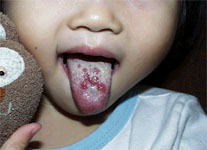 |
 |
 |
 |
 |
 |
Introduction
HFMD is a common illness of infants and children. It is caused by a virus and is characterized by fever, sores in the mouth, and a rash with blisters. HFMD begins with a mild fever, poor appetite, "sick" feeling and frequently a sore throat. One or 2 days after the fever begins, painful sores develop in the mouth. They begin as small red spots that blister and then often become ulcers. They are usually located on the tongue, gums, and inside of the cheeks. The skin rash develops over 1 to 2 days with flat or raised red spots, some with blisters. The rash does not itch, and it is usually located on the palms of the hands and soles of the feet. It may also appear on the buttocks. A person with HFMD may have only the rash or the mouth ulcers. HFMD is a mild disease and nearly all patients recover without medical treatment in 7 to 10 days.
HFMD is moderately contagious. Infection is spread from person to person by direct contact with nose and throat discharges, saliva, fluid from blisters, or the stool of infected persons. A person is most contagious during the first week of the illness. HFMD is not transmitted to or from pets or other animals. The usual period from infection to onset of symptoms ("incubation period") is 3 to 7 days. Fever is often the first symptom of HFMD. No specific treatment is available for HFMD, but symptomatic treatment is given to provide relief from fever, aches, or pain from the mouth ulcers.
Specific prevention for HFMD is not available, but the risk of infection can be lowered by good hygienic practices. Preventive measures include frequent handwashing, especially after diaper changes, cleaning of contaminated surfaces and items by diluted solution of chlorine-containing bleach (made by mixing approximately 1/4 cup of bleach with 1 gallon of water), and washing soiled articles of clothing.
Disclaimer: This information is not intended be a substitute for professional medical advice. It is provided for educational purposes only. You assume full responsibility for how you choose to use this information.